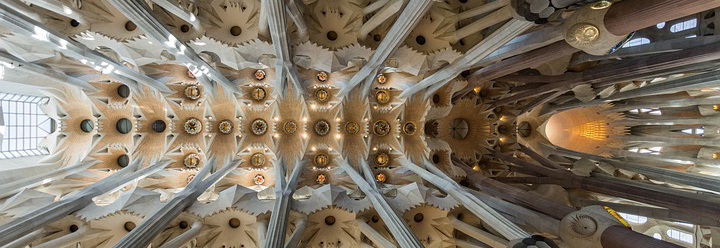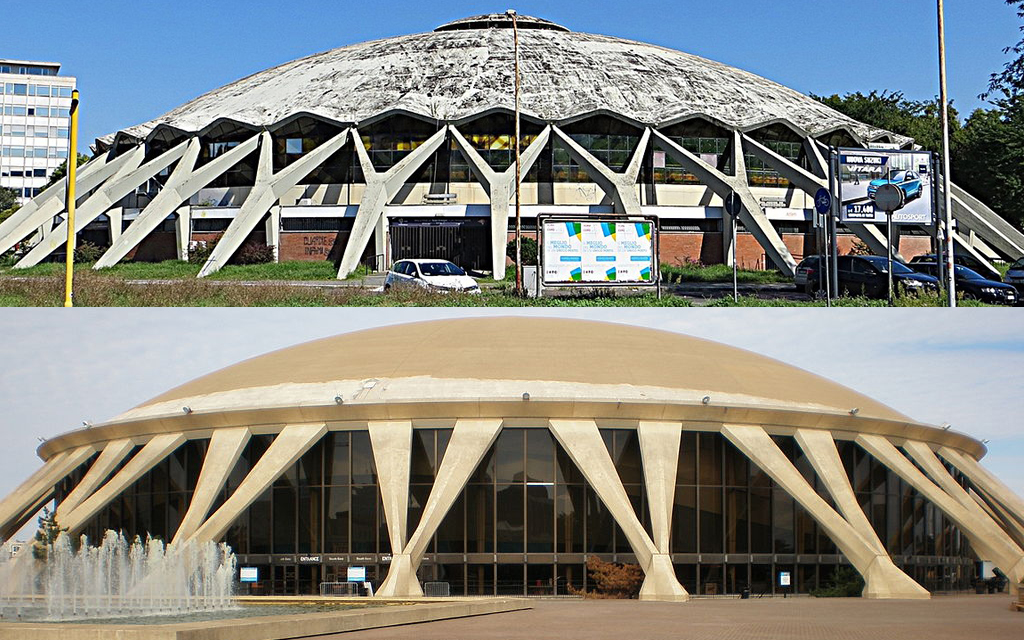Concrete gridshells
It is arguable if the term gridshell, which describes grid structures acting in tension (such as timber gridshells), should be applied to concrete structures, as they primarily act in compression, but there are a number of examples that are historically referred to as, or bear a relationships to, gridshells. In turn as the structural capabilities of concrete as a composite material have developed with fibre reinforcement its ability to act in tension has also improved.
A catenary curve in physics and geometry, is the curve created by self weight when a hanging a chain is supported only at its ends, which bears a relationship to the forms created by gridshells, (only upside down). Antoni Gaudi used hanging chain models to find the optimal shapes for his designs such as for La Sagrada di Fagmilia, whilst the contemporary architect often associated with this construction approach, Frei Otto also used hanging chains to study the optimal shapes for his gridshells.
The earliest thin frame concrete structure resembling a gridshell was an icosaedron dome (refined later into what was called a geodesic dome by Buckminster Fuller). It was completed in the 1920's by the physicist Walther Bauersfeld after being approached by Oskar von Miller to build the first projection planetarium. It was patented and built as a test demonstration on the roof of the Zeiss factory in Jena by Dykerhoff and Wydmann, the shell structure was created effectively as a formwork and the final structure, which when complete was only six centimeters thick, with a diameter of 25 metres, was the first of its kind.
From around the 1920's a number of architects and engineers made developments in the use of thin-shell concrete construction, which, because of its structural efficiency, included the use of of gridshells. Possibly the best known of these was the Italian engineer Pier Luigi Nervi, whose designs started to employ shells in the 1950's starting with the 61 metre ribbed concrete shell dome of the Palazzetto dello Sport in Rome, designed by Architect Annibale Vitellozzi whilst he was under the direction of Engineer Giacomo Maccagno.
This low pitch ribbed dome is braced by concrete flying buttresses on which lie prefabricated concrete panels. It was mostly prefabricated in parts and only took 40 days to be erected. It was arguably not so much a gridshell structure as a shell structure.
The similar shell structure of the Norfolk Scope Arena in Virginia took its inspiration from the earlier building in Rome and was built in 1971 by the same engineer but with double the diameter. In the same year Nervi completed the roof structure of the Paul VI audience hall in Vatican City which was significantly different and started to resemble the fine structural balance associated with gridshells.
Other proponents of thin structure concrete shell frames included Félix Candela Outeriño working in Spain and Mexico on curved flying structures, or cascarones, from the small pavilion of cosmic rays in 1951 to the hotel casino de la Selva, in Cuernavaca, Mexico. In the late 60's and with the growth of steel as a building material he went on to design the large span ribbed gridshell of the Palacio de los Deportes, in Mexico City for the summer Olympics with Enrique Castañeda Tamborel and Antonio Peyri.
Finally and towards the latter period of development Heinz Isler's buildings expanded this typology from the concrete shell roof in Wyss in Zuchwil, (1962), Kilcher in Recherswil, (1965), Deitingen south, triangle concrete cupola roofs, (1968) and later published a number of reports including the Structural Beauty of Shells and the Effective Use of Concrete in the early 80's.
Although Glass Fibre Reinforced Polymers and Plastics (GRP & GFRP) were first invented in the 30's, whilst Glass Fibre Reinforced Concrete (GFRC or GRC) was invented in Russia in the 1940's, for the latter, it wasn't until the 1970's that it came into widespread use in buildings, with the former much later. The introduction of these materials in effect gave new possibilities for the strength of the skins that clad gridshell, or the in another way the gridshells became an integral part of a single material.
[edit] Related articles on Designing Buildings
Featured articles and news
RTPI leader to become new CIOB Chief Executive Officer
Dr Victoria Hills MRTPI, FICE to take over after Caroline Gumble’s departure.
Social and affordable housing, a long term plan for delivery
The “Delivering a Decade of Renewal for Social and Affordable Housing” strategy sets out future path.
A change to adoptive architecture
Effects of global weather warming on architectural detailing, material choice and human interaction.
The proposed publicly owned and backed subsidiary of Homes England, to facilitate new homes.
How big is the problem and what can we do to mitigate the effects?
Overheating guidance and tools for building designers
A number of cool guides to help with the heat.
The UK's Modern Industrial Strategy: A 10 year plan
Previous consultation criticism, current key elements and general support with some persisting reservations.
Building Safety Regulator reforms
New roles, new staff and a new fast track service pave the way for a single construction regulator.
Architectural Technologist CPDs and Communications
CIAT CPD… and how you can do it!
Cooling centres and cool spaces
Managing extreme heat in cities by directing the public to places for heat stress relief and water sources.
Winter gardens: A brief history and warm variations
Extending the season with glass in different forms and terms.
Restoring Great Yarmouth's Winter Gardens
Transforming one of the least sustainable constructions imaginable.
Construction Skills Mission Board launch sector drive
Newly formed government and industry collaboration set strategy for recruiting an additional 100,000 construction workers a year.
New Architects Code comes into effect in September 2025
ARB Architects Code of Conduct and Practice available with ongoing consultation regarding guidance.
Welsh Skills Body (Medr) launches ambitious plan
The new skills body brings together funding and regulation of tertiary education and research for the devolved nation.
Paul Gandy FCIOB announced as next CIOB President
Former Tilbury Douglas CEO takes helm.
UK Infrastructure: A 10 Year Strategy. In brief with reactions
With the National Infrastructure and Service Transformation Authority (NISTA).

























